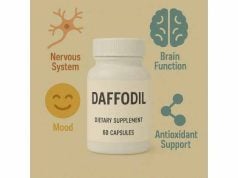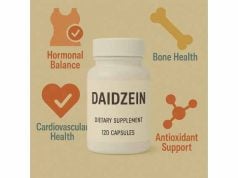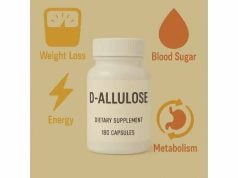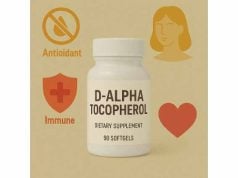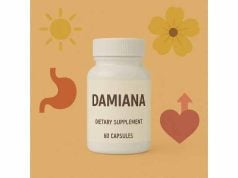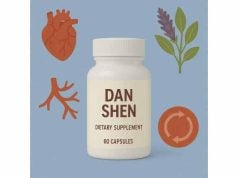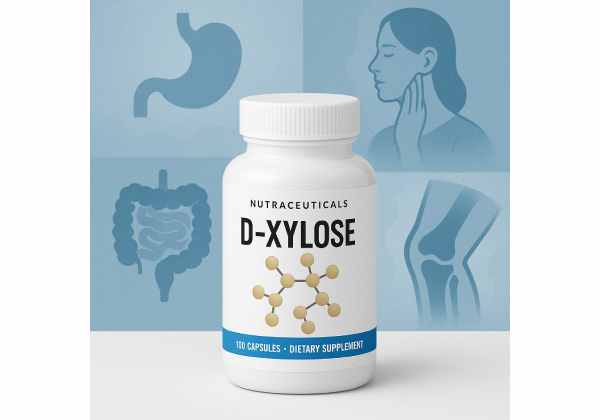
D-xylose is a naturally occurring five-carbon sugar found in plant fibers. Unlike common table sugar, it is absorbed and metabolized differently, and—in small amounts taken with sucrose—can blunt sharp, early spikes in blood glucose and insulin. Researchers have also used D-xylose for decades in the “xylose absorption test” to assess small-intestine function. This guide explains what D-xylose is, how it appears to work, where the evidence stands, how to use it thoughtfully, and who should avoid it. You will find clear dosing ranges grounded in human trials, safety flags (including a lab-testing caveat for people with diabetes), and practical examples so you can decide whether D-xylose fits your goals or a conversation with your clinician.
Top D-Xylose Highlights
- Small doses with sucrose (about 2.5–5 g per 50 g sucrose) can reduce early post-meal glucose and insulin peaks.
- Mechanism: likely slows sucrose breakdown by inhibiting intestinal sucrase, delaying glucose absorption.
- Typical supplemental range: ~2–5 g with a sucrose-containing food or drink; avoid large single doses.
- Safety note: can cause bloating or loose stools at higher intakes; start low and assess tolerance.
- Avoid or seek medical advice if you have diabetes using GDH-based glucose meters, are pregnant, or have significant GI disease.
Table of Contents
- What is D-xylose and how does it work?
- What benefits are supported by research?
- How to use D-xylose with meals
- How much D-xylose per day and per meal?
- Side effects, interactions, and safety
- D-xylose absorption test: what to expect
What is D-xylose and how does it work?
D-xylose is a simple sugar (a pentose; chemical formula C₅H₁₀O₅) found in hemicellulose, the structural carbohydrate in wood, cereal brans, and other plant materials. In food science, it is sometimes used in small amounts to promote browning through the Maillard reaction, and it is a building block for xylitol production. In clinical medicine, D-xylose is the sugar used in the classic “xylose absorption test,” where a standard oral dose is given and then measured in blood and urine to evaluate small-intestinal absorptive capacity.
Why is D-xylose discussed as a nutrition adjunct? Because it behaves differently from sucrose and glucose. A key hypothesis, supported by controlled human studies, is that when D-xylose is co-ingested with sucrose (table sugar), it partially inhibits sucrase—the brush-border enzyme that splits sucrose into glucose and fructose. Slowing this step delays the appearance of glucose in the bloodstream and can attenuate the early postprandial (after-meal) surge in glucose and insulin. Put simply: if sucrose is a fast-unfolding zipper, a bit of D-xylose can make that zipper run more slowly.
A few practical points help frame expectations:
- It is not a zero-calorie sweetener. D-xylose provides energy (roughly similar to other sugars), and pure D-xylose is somewhat less sweet than sucrose. Many readers will use it not to sweeten, but to modulate the glycemic impact of sucrose-containing foods.
- Matrix matters. Drinks and simple gels show clearer glycemic effects than complex solid foods. Fats, proteins, starches, and fibers alter gastric emptying and enzyme access, which can dampen or complicate the impact of D-xylose.
- Timing matters. The effect is acute and most prominent in the first 15–45 minutes after eating a sucrose-rich load. It does not substitute for overall dietary patterns or long-term glucose management.
Mechanistically, beyond sucrase inhibition, studies exploring breath isotopes, gastric emptying, and incretin hormones suggest additional nuances. D-xylose preloads may slow gastric emptying and slightly increase GLP-1 before meals; however, these effects vary by study design and dose. The bottom line: the most consistent finding is a reduced early spike in glucose and insulin when small amounts of D-xylose are taken with sucrose.
What benefits are supported by research?
Human trials—mostly short, crossover designs—give a reasonably coherent picture of D-xylose’s acute benefits when combined with sucrose.
Early-phase glucose and insulin blunting. In healthy adults and in people with impaired fasting glucose, adding D-xylose to a sucrose drink consistently reduces the peak glucose and insulin responses in the first 15–45 minutes post-ingestion. The effect size depends on dose and food matrix:
- In controlled drink studies using ~50 g sucrose, adding ~5 g D-xylose (≈10% of sucrose by weight) lowered early glucose and insulin peaks compared with the same drink without D-xylose.
- Lower doses (2.5–3.33 g with 50 g sucrose) still attenuated glucose at specific early time points (often around 30 minutes) and reduced insulin at 15–30 minutes in normal and hyperglycemic subjects.
- When D-xylose was included in solid foods (e.g., muffins containing sucrose, alongside fat and starch), glucose effects were smaller or inconsistent, though early insulin peaks sometimes still declined. This underscores the matrix effect: liquids tend to show clearer responses than mixed solid foods.
Possible synergy with DPP-4 inhibition (clinical context). In a small study in type 2 diabetes, a D-xylose preload given before a mixed carbohydrate meal reduced postprandial glycemia. When combined with a DPP-4 inhibitor taken before the preload, the overall glucose profile improved further. This is specialized (and uses a large single load of D-xylose not intended for routine supplementation), but it reinforces the mechanistic idea that blunting early sugar absorption can work in tandem with therapies that sustain incretin action.
What benefits not to expect (based on current data).
- Long-term A1C or weight change: Trials to date are acute (minutes to hours). There is not yet convincing evidence that intermittent D-xylose use meaningfully lowers A1C, fasting glucose, or body weight over months. If you use D-xylose, treat it as a meal-level tool, not a substitute for dietary and lifestyle management.
- Effects with starch-dominant meals: Because D-xylose targets sucrose breakdown, its impact is naturally smaller when most carbohydrates are starches, especially if the meal includes fat and protein that slow digestion.
How sweet is D-xylose? You will sometimes see it described as about 60% as sweet as sucrose. That matches user experience and helps explain why it is typically added in gram-level amounts to sucrose-sweetened products rather than used alone as a tabletop sweetener.
Summary of evidence quality: The human evidence is moderate for acute blunting of early post-prandial glucose and insulin with sucrose-containing beverages at ~5 g doses. Evidence is limited to small, short studies, with mixed findings in complex solid foods and minimal long-term outcomes. For everyday use, this means D-xylose may be helpful with sucrose-rich drinks and simple desserts to soften the early glycemic spike, but it is not a comprehensive glycemic control strategy on its own.
How to use D-xylose with meals
If you decide to try D-xylose, frame it as a targeted add-on for sucrose-containing foods and beverages—especially those you occasionally enjoy but want to make less glycemically “spiky.”
General approach
- Identify the use case. D-xylose is most relevant when a food or drink contains a meaningful amount of sucrose (e.g., sweetened tea, lemonade, a fruit-based beverage, a sorbet, or a dessert syrup). It is less relevant with starch-only foods (e.g., plain pasta) or with non-nutritive sweeteners.
- Add it to the item—not separately. Stir the measured amount directly into the sucrose-containing drink or incorporate it into the dessert mixture so it is present where sucrase will act.
- Mind the matrix. Liquid applications (drinks, syrups, simple gels) show more consistent effects than complex baked goods. If you use it in a muffin, cookie, or ice cream, expect smaller or less predictable changes.
- Start low, step up. Begin near the low end of the effective range; assess tolerance and your own post-meal readings if you monitor glucose.
Practical examples
- Sweetened iced tea (≈25 g sucrose in a large glass): Stir in ~2–3 g D-xylose (about ½ to ¾ teaspoon, depending on product density). Taste, then adjust if desired.
- Fruit-based drink (≈50 g sucrose): Add ~5 g D-xylose (≈1 teaspoon). This mirrors doses used in controlled studies and is a straightforward starting point.
- Simple syrup for sorbets: Dissolve D-xylose alongside sugar at a 10:1 sucrose\:xylose weight ratio (e.g., 100 g sucrose + 10 g D-xylose per batch), then proceed with your recipe.
- Dessert topping or sauce: If your sauce uses 50 g sucrose, whisk in ~5 g D-xylose as it dissolves. For a lighter sauce with 25 g sucrose, use ~2–3 g.
When to add it
The effect is co-ingestion dependent: include D-xylose in the item you will consume, or mix it just before consumption. There is no need to take it alone far in advance of the meal (except in specialized “preload” protocols not intended for routine use).
Taste and culinary notes
- D-xylose is less sweet than sucrose and can slightly change flavor development (it participates readily in browning). In beverages at the gram levels above, most users do not notice a strong taste difference.
- Because it draws water and participates in browning, in baked goods it may subtly affect texture or color; test small batches first.
Not a replacement for overall patterns
Even when used optimally, D-xylose addresses a single mechanism—early sucrose hydrolysis. If glycemic management is your goal, continue to anchor meals in minimally processed foods, fiber, protein, and healthy fats, and use D-xylose sparingly to “soften the spikes” when you choose sucrose-rich items.
How much D-xylose per day and per meal?
Evidence-based starting points
- Per item (with sucrose): A practical, study-aligned range is ~2–5 g D-xylose per 25–50 g sucrose (roughly a 10:1 sucrose\:xylose ratio by weight).
- Upper end for simple drinks: Up to ~7.5 g with 50 g sucrose has been tested in healthy adults. Effects above that level do not appear proportionally larger and may raise the chance of gastrointestinal discomfort.
- Daily total: There is no established “daily limit” for general use, but a conservative ceiling for most adults is ~10–15 g/day, split across items, until you understand your tolerance. Many people will use far less because D-xylose is only added when sucrose-rich items are consumed.
Special notes on “preloads”
Some clinical research used large, one-time loads of D-xylose (e.g., 50 g) as a preload 30–40 minutes before a test meal to study gastric emptying and hormones. This is not a routine or recommended supplemental strategy for daily life—it adds substantial sugar and calories and may cause GI upset. Consider these preload studies as mechanistic rather than practical dosing guidance.
Timing
- Add D-xylose with the sucrose-containing food or drink.
- For mixed solid foods, effects are attenuated; pairing with a simple beverage or dessert course that contains sucrose will better mirror study conditions.
Who might use lower starting doses?
- Individuals with a history of irritable bowel symptoms, sensitivity to sugars or sugar alcohols, or rapid GI transit may prefer 1–2 g as an initial test.
- People seeking only a marginal tweak to a recipe’s glycemic impact can stay at the low end to minimize any sensory or digestive changes.
Who should avoid self-dosing altogether?
- Anyone with active GI disease or recent GI surgery without clinician guidance.
- Pregnant or breastfeeding individuals (limited data).
- People with diabetes who rely on GDH-based blood glucose meters (see safety section); if you cannot confirm your meter type, do not experiment without professional input.
Children and teens
D-xylose is used medically in children during the absorption test under professional supervision, but routine supplemental use to modify meals is not established. Avoid in minors unless a pediatric clinician specifically advises otherwise.
How to read labels and measure
Many suppliers sell pure D-xylose as a white crystalline powder. Because densities vary slightly, weighing with a small kitchen scale is most accurate. If you use volume measures, 1 teaspoon of D-xylose powder is typically around 3–5 g, depending on grind and packing.
Side effects, interactions, and safety
Digestive tolerance
D-xylose is a sugar and, at higher doses, can draw water into the gut and speed transit, causing bloating, gas, or loose stools. In small amounts (≈2–5 g with a drink), many healthy adults tolerate it well. In studies that carefully monitored symptoms, gram-level additions to beverages or light foods were generally acceptable. If you notice GI effects, reduce the dose or discontinue.
Blood glucose monitoring caveat
D-xylose can interfere with certain blood glucose meters, specifically some systems that use glucose dehydrogenase (GDH)-based chemistry. These meters may falsely read xylose as glucose, giving artificially high readings. That could lead to inappropriate insulin dosing if you assume the reading reflects true glycemia. If you have diabetes and self-monitor glucose:
- Check your meter’s technology (ask your diabetes team or consult the manufacturer).
- If your device is GDH-based and susceptible to interference, avoid taking D-xylose around measurement times, or switch to a glucose-specific method after consulting your clinician.
- Continuous glucose monitors (CGMs) vary in chemistry; discuss with your care team before experimenting.
Medication and condition considerations
- DPP-4 inhibitors: In a small study, a D-xylose preload enhanced post-meal glucose control when combined with a DPP-4 inhibitor. This is not a clinical recommendation to pair them; it does suggest no obvious adverse interaction at study doses.
- GI disorders: If you have celiac disease, inflammatory bowel disease, chronic diarrhea, or small intestinal bacterial overgrowth, avoid self-experimentation and consult your gastroenterologist.
- Kidney disease: D-xylose is partly excreted in urine. While gram-level culinary use is unlikely to be harmful, any renal impairment complicates interpretation of D-xylose laboratory tests and may alter handling; seek individualized advice.
- Pregnancy and lactation: There is insufficient data on supplemental D-xylose; prioritize established dietary patterns and avoid non-essential additives unless your clinician advises otherwise.
- Allergies: True allergies to simple sugars are rare; most adverse reactions are intolerance rather than immune-mediated allergy.
Who should not use D-xylose
- People who cannot verify that their glucose meter does not cross-react with xylose (if they rely on finger-stick readings for dosing decisions).
- Individuals with ongoing significant GI symptoms or unexplained weight loss.
- Those directed by their clinician to avoid additional simple sugars entirely.
Lab and test interactions
If you are scheduled for a D-xylose absorption test, avoid adding D-xylose to foods or drinks for a few days prior unless the testing laboratory provides different instructions. Follow pre-test fasting and collection instructions closely so results are interpretable.
Bottom line on safety
At the low, meal-level doses described in this guide, D-xylose appears well tolerated in healthy adults, with GI symptoms as the main limitation. The principal safety caveat is meter interference for some people with diabetes. When in doubt, do not use D-xylose without clinician guidance.
D-xylose absorption test: what to expect
Because D-xylose doubles as a diagnostic tool, it is helpful to separate supplement-style use from medical testing.
Purpose
The D-xylose absorption (or “xylose tolerance”) test assesses how well your small intestine absorbs a simple sugar. It is sometimes used when malabsorption is suspected due to chronic diarrhea, unexplained weight loss, or nutritional deficiencies. While used less often today (newer modalities and celiac serology have reduced demand), it remains a valid, accessible option in many centers.
Typical adult protocol (may vary by lab)
- After an overnight fast, you drink a measured solution containing 25 g of D-xylose in water.
- Blood samples may be drawn at 1 and 3 hours (some protocols collect more time points).
- Urine is collected for 5 hours, with total volume measured.
- The lab quantifies how much D-xylose appears in blood and in the 5-hour urine. Adequate levels suggest the intestine is absorbing properly; lower values suggest malabsorption (intestinal disease), although poor kidney function, dehydration, or incomplete urine collection can also lower urinary recovery and confound interpretation.
How results are interpreted
Laboratories use specific reference intervals and may adjust interpretation based on age and renal function. The clinician correlates results with symptoms, diet, and other tests. Because dehydration and kidney impairment can falsely lower urinary excretion, many labs emphasize adequate hydration during the test and careful sample handling.
What you might feel
Most people tolerate the test well. The dose and volume of sugar water can occasionally cause mild nausea, bloating, or loose stools. During the test window you may be asked not to eat, smoke, or engage in vigorous activity, as these can affect results.
Preparation tips (always follow your lab’s instructions)
- Fast as instructed (commonly 8–12 hours beforehand).
- Hydrate as permitted and avoid vigorous activity during the collection period.
- Take only the medications your clinician allows before the test (some drugs can alter results).
- Accurately collect and record all urine during the 5-hour period if your lab uses a urine endpoint.
After the test
You will resume normal eating unless instructed otherwise. Your clinician will discuss the numbers, their meaning, and next steps (e.g., celiac evaluation, imaging, breath testing) if malabsorption is still suspected.
Important distinction
Using D-xylose as a culinary adjunct is not the same as undergoing a diagnostic test. If you have upcoming testing, inform your clinician about any supplement use so timing can be adjusted.
References
- L-arabinose and D-xylose: sweet pentoses that may reduce postprandial glucose and insulin responses (2021) (Randomized trial and review context).
- Beneficial effect of xylose consumption on postprandial hyperglycemia in Korean: a randomized double-blind, crossover design (2016) (RCT).
- Effects of a D-xylose preload with or without sitagliptin on gastric emptying, glucagon-like peptide-1, and postprandial glycemia in type 2 diabetes (2013) (RCT).
- D-xylose absorption (2024) (Medical test overview and procedure).
- Impact of Xylose on Glucose-Dehydrogenase-Based Blood Glucose Meters for Patient Self-Testing (2016; updated context supported by 2023 methodology papers) (Safety—device interference).
Medical Disclaimer
This information is for educational purposes and is not a substitute for personalized medical advice, diagnosis, or treatment. D-xylose can affect laboratory measurements and some glucose meters; if you have diabetes, gastrointestinal disease, are pregnant or breastfeeding, or take prescription medications, consult your healthcare professional before using D-xylose. Never change your prescribed treatment or diabetes monitoring approach without medical guidance.
If you found this guide useful, please consider sharing it on Facebook, X (formerly Twitter), or your favorite platform, and follow us for more evidence-based nutrition explainers. Your support helps us keep producing high-quality content.

